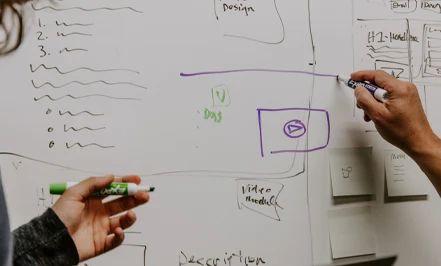
MVP vs Prototype: What Founders Need To Know To Win Investment

by Dave Westbrook,
08-May-2025
Building a new product is one of the most exhilarating and high-stakes decisions a founder can make. From customer discovery to pitch decks, every step matters. But one of the earliest and most pivotal choices you’ll face is this: Should you start with a prototype or go all in on an MVP (Minimum Viable Product)?
This is a strategic decision as mush as it is a technical one. The right approach can open the door to investors, build early traction, and save you months of rework. The wrong approach could burn your budget and hamper your momentum.
In this guide, we’ll break down what MVPs and prototypes really mean, answer some of the most common questions founders ask about them, and help you pick the right approach based on your goals and resources.
What Does MVP Stand For?
MVP stands for Minimum Viable Product, and it's a term that’s become a cornerstone of lean startup methodology. It describes the simplest version of a product that can be released to real users to generate feedback, validate assumptions, and (ideally) start gaining traction.
But it’s also a phrase that gets thrown around loosely, often confused with a prototype, mock-up, or even a beta product. That’s why clear definitions matter.
MVP vs Prototype: What’s the Difference?
Let's make it clear...
- Prototype: A rapidly produced model used to demonstrate your product idea. It's usually a front-end demo (our preferred approach), but it could be a clickable design in e.g., Figma, or even just a slide deck. Its main goal is to communicate vision, not to scale or support real users.
- MVP: A functional, launch-ready product with only the essential features needed to solve a specific problem for early adopters. It’s built to test your value proposition in the real world—and it’s capable of generating feedback, usage data, and even early revenue.
Think of it like this... a prototype is your concept car. It doesn't have an engine, but it's sleek and designed to make an impression. On the other hand, your MVP is your first production car. It has all the important features and is ready to drive away.
When Should You Use a Prototype?
Prototypes are ideal when your goal is to communicate your product vision quickly. If you’re preparing for an accelerator pitch, initial investor meetings, or early user testing, a prototype helps tell your story with clarity and speed without the cost of full development.
We saw this in action with our client RiskApp. They used a clickable front-end prototype to visualise and demonstrate their value proposition to investors. That prototype didn’t support users, but it helped them secure the funding needed to build the full MVP. What did we do? We built the front-end ready to develop into a full MVP. That’s the power of showing, and building for, the future.
When Should You Build an MVP?
If your next milestone involves onboarding real users, gathering usage data, or showing traction to investors, then it’s MVP time.
Yes, an MVP takes longer than a prototype. But it gives you something real. Something that can be tested, improved, and scaled. And when you choose the right development partner, that MVP can be developed directly from a prototype and grow with your business instead of being rebuilt from scratch.
That’s why many founders turn to startup app development teams with experience in scalable architecture, user onboarding, and iterative releases.
Side Note: What is an MVP in Business?
In business, an MVP is usually more than a software or product build. It’s a strategic play that enables you to:
- Validate demand before scaling
- Minimise wasted effort on features no one wants
- Accelerate your time to market
- Start building a customer base or user community (whether that's internal users or your customers)
- Demonstrate traction to senior stakeholders
For internal innovation teams, the MVP isn’t the finish line. It’s the launchpad. That’s why so many organisations partner with third-party expert teams for investor-ready MVPs to ensure their product is technically sound and strategically aligned with the expectations of senior stakeholders.
The Investors' Perspective: What Do They Really Want?
Here’s what seasoned investors know: a slick demo doesn’t prove market fit. Too many beautifully designed prototypes have failed to convert when built out.
But a live MVP (even one with only selected essential features) signals something powerful. It says:
“We’re not just dreaming. We’re doing. We’ve built something real, we’re learning fast, and we have the stats to back it up.”
That kind of signal earns attention. It shows resourcefulness, market clarity, and execution. All things investors love.
That said, the right prototype can spark investor FOMO. If you’ve identified a red-hot problem and demonstrated a clear market opportunity, even a minimal demo can get the imagination flowing. We’ve helped startups use both tools effectively, depending on their funding stage and audience.
Choosing What's Right For You
So how do you decide?
Ask yourself these questions:
- Do I need user feedback to improve my idea? → Go MVP.
- Do I need to pitch a vision to secure intros or early backing? → Go prototype.
- Do I have the budget and technical support to build something stable? → Consider starting with an MVP.
- Am I in a tight spot and need to move fast? → A prototype can get you in the room.
Just remember: the prototype is a means to an end. If you go that route, have a clear plan for transitioning to a robust MVP once you’ve validated the concept.
The Role of Data & AI in Modern MVPs
Today’s MVPs don’t just solve surface-level problems. Increasingly, they’re expected to deliver smarter, data-driven experiences. Founders are leveraging data engineering and AI to power recommendations, automate decisions, and offer real-time insights from day one.
If your idea involves intelligent features like personalisation, analytics, or automation, baking in the right data architecture early can save you months of retrofitting later.
Another Side Note: What Is MVP at Work?
Let's not get confused... MVP has a different meaning: those people at work who master the important skills are highly valued. They are often referred to as MVPs (or Most Valuable Players). Being an MVP is a big honour in any context. This recognition comes from dedication, application, and hard work.
In a product development terms, “MVP” often refers to the people that facilitate the fastest route to creating something of value that can be tested and improved. It encourages a culture of experimentation, learning from users, and iterating quickly.
For startups, this translates to lean, agile development practices. You’re not aiming for perfection, you’re aiming for momentum.
Final Thoughts: Your Product is Your Pitch
Whether you choose to start with a prototype or dive into an MVP, make sure your build aligns with your next milestone.
- Want to prove the vision? Prototype.
- Want to prove the traction? MVP.
Just don’t get caught in endless mock-ups or overengineered versions that never launch. Keep the focus on learning, iteration, and real-world feedback.
Both paths, when used wisely, should converge on the same goal: a secure, scalable product that delights users and attracts investment.
Ready to Take the Next Step?
Need help choosing the right approach or building a product investors will love? From idea sketching to full-scale MVPs, we’re here to guide your journey.
- Explore our startup app development services
- Move quickly and build an investor-ready MVP
Let’s bring your vision to life. Schedule a call today and start building with confidence.




